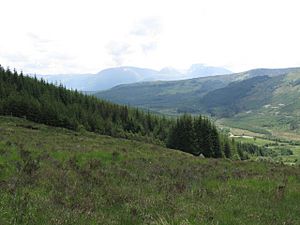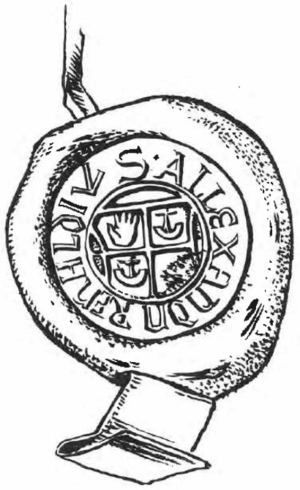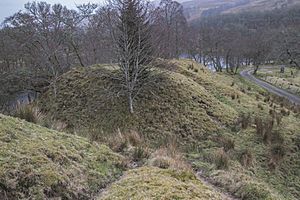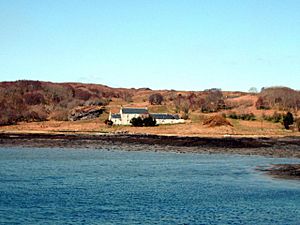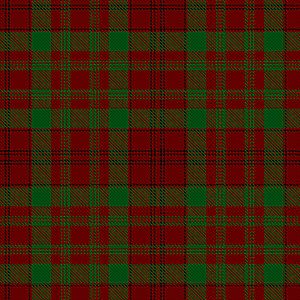Clan MacDonald of Keppoch facts for kids
Quick facts for kids Clan MacDonald of Keppoch |
|||
|---|---|---|---|
| Clann Dòmhnaill na Ceapaich, Clann Mhic Raghnaill na Ceapaich | |||
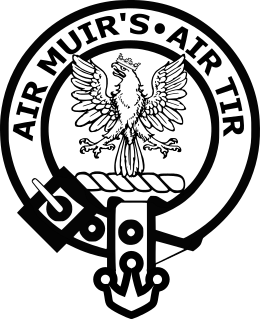
Crest: An eagle displayed, Gules, crowned of a ducal coronet, Or
|
|||
| Motto | Air Muir's Air Tir (By Sea By Land) | ||
| War cry | Dia 's Naomh Aindrea! (God and St Andrew!) | ||
| Profile | |||
| Region | Scottish Highlands | ||
| District | Lochaber | ||
| Plant badge | Common Heath | ||
| Chief | |||
 |
|||
| Ranald Alasdair MacDonald of Keppoch | |||
| Historic seat | Keppoch Castle | ||
|
|||
|
|||
|
|||
|
|||
Clan MacDonald of Keppoch, also known as Clan MacDonell of Keppoch, is a famous Highland Scottish clan. It is a branch of the larger Clan Donald. The clan's founder was Alistair Carragh MacDonald, a descendant of the great warrior Somerled. The clan chief is traditionally called "Mac Mhic Raonuill," which means "Son of Ranald's son" in Scottish Gaelic.
Historically, the Clan MacDonald of Keppoch was known for its strong loyalty to the House of Stuart, the royal family of Scotland. They played a big part in the Jacobite uprisings of the 17th and 18th centuries, especially the Jacobite rising of 1745. These were times when people fought to bring the Stuart kings back to the throne. The clan also had many disagreements over land and sometimes raided cattle from other clans, especially their rivals, Clan Mackintosh.
Today, the Clan MacDonald of Keppoch has a chief officially recognized by the Court of the Lord Lyon. This court is the official authority for Scottish heraldry, which deals with coats of arms and clan recognition.
Contents
History of the Keppoch MacDonalds
Clan Origins
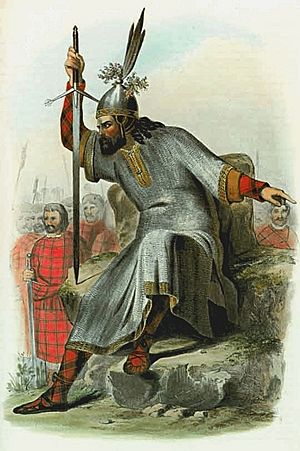
The MacDonalds of Keppoch are part of Clan Donald, one of Scotland's largest clans. Clan Donald gets its name from Donald, who was the son of Reginald, who was the son of Somerled. Somerled was a powerful leader in the 1100s. He was a Norse-Gaelic warrior who became known as the "King of the Isles." He built a large kingdom by marrying into powerful families and winning battles.
The area of Lochaber was given to Aonghus Óg of Islay by Robert the Bruce. Aonghus Óg was a friend of Bruce and fought with him in the First War of Scottish Independence, including the important Battle of Bannockburn in 1314. This gift showed how important Aonghus Óg and his clan were to Bruce.
The Keppoch MacDonalds come from Alistair Carragh MacDonald. He was a younger son of John of Islay, Lord of the Isles, who was the 6th chief of Clan Donald. John of Islay gave the lands of Lochaber to Alistair Carrach. Alistair Carrach MacDonald was the first MacDonald of Keppoch. The clan lived in the Keppoch and Lochaber areas, between Loch Linnhe and Loch Leven, near Spean Bridge.
15th Century Events
Alistair Carrach MacDonald of Keppoch supported his brother, Domhnall of Islay, Lord of the Isles, in his claim to the Earldom of Ross. After Domhnall died in 1425, the land of Lochaber was taken by the Crown. It was then given to the chief of Clan Mackintosh. However, the Lord of the Isles still had some power over the land and gave it back to Alistair Carrach MacDonald.
The Crown never agreed to this, so when the Lordship of the Isles was lost in 1493, Angus MacDonald, the 2nd chief of Keppoch, had to fight to keep his position in Lochaber. The MacDonalds of Keppoch defended these lands for over 250 years. It wasn't until after the Battle of Culloden in 1746 that the Mackintoshes finally became the true lords of Lochaber.
Around 1480, Donald Angusson MacDonald, the 3rd chief, led the Keppoch MacDonalds to fight alongside Aonghas Óg MacDonald against his own father, John of Islay, Earl of Ross, at the Battle of Bloody Bay. Aonghas Óg won this battle. After the Lordship of the Isles was lost in 1493, Donald Angusson of Keppoch paid his respects to James IV of Scotland. But Donald continued to challenge the king, and in 1497, his title and lands were taken away. Donald was killed fighting the Stewarts of Appin.
His son, Iain Aluinn, became the 4th chief for a short time. He angered his clan by giving a thief to the Mackintoshes, who were enemies of the MacDonalds. The clan was very upset that Iain Aluinn gave in to the Mackintoshes. They chose Alexander, a grandson of Alistair Carrach, as their next chief. Alexander was soon killed. His son, Donald Glass, had better luck and built the first Castle Keppoch in Lochaber.
In 1497 or 1498, Clan MacDonald of Keppoch fought and defeated the Clan Stewart of Appin and the Clan MacLaren at the Battle of Black Mount. Both the chiefs of Appin and Keppoch were killed in this battle.
16th Century Conflicts
The next chief, Ranald Mor, the 7th chief of Keppoch, strongly supported John Moidartach, the 8th chief of Clanranald. Ranald Mor helped John Moidartach lead the Clan Ranald of Garmoran in a fight for leadership of their clan. Ranald Mor also fought at the Battle of the Shirts, helping the MacDonalds of Clanranald and Clan Cameron against Clan Fraser of Lovat. It is said that only a few men from each side survived this fierce battle.
After Lord Lovat was killed, the Earl of Huntly attacked Lochaber and raided the lands of Keppoch. However, he could not capture Ranald Mor. In 1547, Ranald Mor and Ewen Allanson of Lochiel were arrested and put in prison. They were later executed in 1547 for their part in the conflict that led to Lord Lovat's death.
After Ranald Mor's death, future Keppoch chiefs were called "MacRanald." The Keppoch clan became known as the Clanranald of Lochaber. From Ranald Mor onwards, the chiefs would use the Gaelic name "Mac Mhic Raonuill", which means "son of Ranald's son." This became the traditional way to refer to the future chiefs of Clan Keppoch.
17th Century Challenges
Alexander nan Cleas, the 10th chief of Keppoch, was known as "the tricky." He was involved in many serious events. He had to leave Scotland for Spain after helping Sir James MacDonald, 9th of Dunnyveg, escape from Edinburgh Castle. He only returned after offering King James VI secret information about a possible Spanish invasion. Alexander was even given a pension and lived the rest of his life peacefully.
Alexander was followed by his son, Alexander, known as "Alastair Boloyne." He became chief and celebrated with a "creach," which was a traditional raid to show his power. Alexander of Keppoch and his followers raided the rich lands of Urquhart, Glen Shee, and Strathardle, taking everything they could. Later, he and his friends were given a special pardon for 21 years.
Alexander had many disagreements with his Cameron neighbors. These arguments led to a clan battle at Boloinne, where the Camerons were defeated. Alexander of Keppoch was badly wounded. His brother, John Dubh of Bohuntin, took over and chased the Camerons across Loch Lochy. This battle between the MacDonalds of Keppoch and the Camerons happened in February 1554. Alexander of Keppoch died from his wound shortly after this battle. His brother, Ranald Og, became the next chief.
Ranald Og, the 9th chief, was known for his loyalty to the Scottish throne and good relations with the Campbells. He supported Charles I of England during the English Civil War. This led to a personal fight with the Earl of Argyll, who attacked Lochaber and destroyed Castle Keppoch. Over the next few years, Ranald's younger brother, Donald Glass, got revenge by raiding Argyll with the forces of the Marquess of Montrose.
In 1663, Alexander MacDonald, the 13th chief of Keppoch, and his brother were killed in an event known as the Keppoch murders. The heads of the seven people responsible were washed at Tobair-nan-ceann (meaning "Well of Heads" in Scottish Gaelic) before being shown to Lord MacDonell of Invergarry.
In 1681, Gilleasba, the chief of Keppoch, made an agreement with John Glas, the first Earl of Breadalbane. In this agreement, Keppoch promised to stop all the people of Brae-Lochaber and all Macdonells from stealing within the Earl's lands.
Coll MacDonald, the 16th chief of Keppoch, became chief after his father's death. He tried to settle differences with the Mackintoshes peacefully. However, the Mackintoshes arrested the young chief and imprisoned him in Inverness without a trial. Coll was released in 1683, which only made his anger towards the Mackintoshes grow stronger.
In 1688, the Mackintoshes, with help from Clan Chattan and the government, made a final attempt to take Lochaber from the MacDonalds of Keppoch. This led to the Battle of Mulroy, which is considered the last private battle between Highland clans. The young 16th chief of Keppoch led his men against a much larger force. Even though they were outnumbered, the MacDonalds of Keppoch won the battle, and the enemy leader was killed. Coll then raided the Mackintosh lands. Later, Coll's clansmen joined the Jacobite cause and fought for Viscount Dundee.
Jacobite Uprising of 1689
During the Jacobite rising of 1689, the MacDonalds of Keppoch attacked the town of Inverness. Soon after, they fought at the Battle of Killiecrankie, where the Jacobites won a victory.
18th Century Uprisings
Jacobite Uprising of 1715
During the Jacobite rising of 1715, Clan MacDonald of Keppoch was involved in the siege of Inverness (1715). In 1724, a report estimated the clan had about 220 fighting men. Coll MacDonald and his clansmen fought for the Jacobites at the Battle of Sheriffmuir. After the Jacobite Rising of 1715 failed, Coll MacDonald went to France for a while but kept his power. He died in 1729.
Jacobite Uprising of 1745
During the Jacobite rising of 1745, the Chief, Alexander Macdonald, 17th of Keppoch, and his men attacked British Government soldiers. This happened at what is now called the Highbridge Skirmish. This was the first attack on the government during the 1745 rising. The MacDonalds of Keppoch also took part in the siege of Fort William in March 1746.
On April 16, 1746, Clan MacDonald of Keppoch was at the Battle of Culloden. It is said that Alexander of Keppoch, seeing his men hesitate, shouted, Mo Dhia, an do thrèig clann mo chinnidh mi? ("My God, have the children of my clan forsaken me?") before charging forward alone. Other stories say he led the attack with a small group of family members, with the rest of his men following. During the attack, Keppoch was badly wounded and died later while being carried off the field. His regiment fought bravely but suffered many losses after the Jacobite defeat.
Major Donald MacDonald, a leader from Tir na Dis near Spean Bridge, was executed at Carlisle in October 1746 after the uprising failed. Before his death, he stated that he joined the Prince out of duty to his rightful ruler, not to establish a specific religion.
Alexander was followed by his son, Ranald, the 18th Chief, and then by Richard, the 19th Chief. The chiefship became inactive in 1848 when Chichester, the 21st Chief, died.
19th Century to Today
John de Lotbinière MacDonald (1857–1935) was the 21st clan chief. After his death, there was little record of the clan's leadership, as the original line of Coll MacDonald, 16th of Keppoch, ended. The clan was without a chief for several generations.
A new chief was finally recognized on September 13, 2006. Ranald Alasdair MacDonald of Keppoch was acknowledged as the lawful chief by the Lyon Court. This happened after a 30-year effort to gain the right to use the old title of Mac Mhic Raonuill. His family line was accepted by the Court.
List of Clan Chiefs
Here is a list of the historical chiefs of the Clan MacDonald of Keppoch:
- Alexander Alisdair Carrach MacDonald, 1st of Keppoch (1369-1440)
- Angus Aonghas na Fearste MacDonald, 2nd of Keppoch (1390-1484)
- Donald MacDonald, 3rd of Keppoch (before 1484–1497)
- John Iain Aluinn Macdonald, 4th of Keppoch (before 1497-?)
- Alexander Alastair nan Gleann Macdonald, 5th of Keppoch (before 1484–1499)
- Donald "Glass" MacDonald, 6th of Keppoch (before 1499-~1513)
- Ronald "Raonall MacDhonaill Ghlais" MacDonald, 7th of Keppoch (before 1513–1547)
- Alexander Alastair Boloine MacDonald, 8th of Keppoch (before 1547–1554)
- Ranald Og MacDonald, 9th of Keppoch (before 1547–1587)
- Alexander Alastair nan Cleas MacDonald, 10th of Keppoch (after 1547- after 1640)
- Ranald Og Macdonald, 11th of Keppoch (before 1593–1640)
- Donald "Glass" MacDonald, 12th of Keppoch (before 1593-before 1650)
- Alexander MacDonald, 13th of Keppoch (before 1650–1663)
- Alexander Alastair Buidhe MacDonald, 14th of Keppoch (before 1593–1669)
- Archibald MacDonald, 15th of Keppoch (after 1663–1688)
- Coll MacDonald, 16th of Keppoch (before 1688–1729)
- Alexander Macdonald, 17th of Keppoch (before 1729–1746) (Killed at the Battle of Culloden)
- Sir Ranald MacDonell, 18th of Keppoch (1736-1788)
- Sir Alexander MacDonell, 19th of Keppoch (1772-1808)
- Sir Richard MacDonell, 20th of Keppoch (1780-1819)
- Sir Chichester MacDonell, 21st of Keppoch (before 1819–1848)
The current chief is Ranald Alasdair MacDonald, the 22nd Chief of the Honorable Clan Ranald of Lochaber. He became chief in 2006.
Clan Castle
The original home of the Clan MacDonald of Keppoch chiefs was Castle Keppoch, near Spean Bridge in Lochaber. In 1690, it passed to the Mackintoshes. The land was often fought over with the Mackintoshes, and the last clan battle happened here. The castle itself was torn down in 1663 after the Keppoch murders.
The current Keppoch House was built around 1760 by the 18th chief of the MacDonells of Keppoch. This house stands where an earlier Keppoch House once was. That older house was built in the late 1600s and was burned down by government troops after the Battle of Culloden.
Clan Profile
- Clan Chief: The chiefs of Clan MacDonald of Keppoch are traditionally called "Mac Mhic Raonuill". The current chief is Ranald Alasdair MacDonald of Keppoch, who is the 22nd Chief.
- Chiefly Arms: The current chief's coat of arms has a lion, an armored hand holding a cross, a ship, and a salmon.
- Clan Member's Crest Badge: Clan members can wear a crest badge. It shows a golden eagle with its wings spread, wearing a crown. The motto on the badge is AIR MUIR'S AIR TIR, which means "By Sea By Land" in Scottish Gaelic.
- Clan Badge: The plant badge for the clan is common heather. This plant is also used by other MacDonald clans.
- Pipe Music: Several bagpipe tunes are linked to the clan. These include Spaidsearachd Alasdair Charraich ("Alasdair Carrach’s March"), Ceapach na fasaich ("Keppoch in the Wilderness"), Latha na Maoile Ruadh ("The Day of Mulroy"), and An tarbh breac dearg ("The Red Speckled Bull"). Another tune is "MacDonald took the Brae on them," played after their victory at the Battle of Mulroy.
- Gaelic Name: Clann Dòmhnaill na Ceapaich, Clann Mhic Raghnaill na Ceapaich
Tartan
The MacDonald of Keppoch tartan has colors of red, dark green, navy, and sky blue.
One story says that the MacDonald of Keppoch tartan pattern was copied from a plaid given to Prince Charles Edward Stuart. However, another clan, Clan Johnstone, claims the same thing about a different tartan pattern.
See also
- Sìleas na Ceapaich
- Ailean a' Ridse MacDhòmhnaill
- Ranald MacDonald (bishop)
- Allan MacDonald (poet)
- Macdonald, other things named Macdonald on Wikipedia


